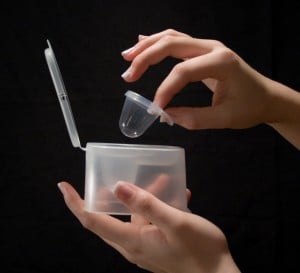by Stacie Longwell Hill, guest blogger
Editorial note from Ellen: I was thrilled to recently make the acquaintance of Stacie Longwell Hill, who has experience in both bioethics and as an embryologist in a fertility clinic. She shares my Christian faith, and has worked alongside Christian physicians treating couples for infertility. Stacie currently works in marketing for Conceivex, a company that has developed a “Conception Kit” to help couples perform insemination treatments at home to overcome some common causes of infertility. Because the kit is used in the context of regular marital intercourse, a number of Catholic bioethicists have endorsed it as consistent with their stance on reproductive technologies. I asked Stacie to write this post, not to sell readers on this product, but to highlight ways that clinicians and biotech companies are meeting a need for lower-tech interventions for couples uncomfortable with high-tech options such as IVF for a variety of reasons, including ethical, medical, and theological concerns. I am pursuing connections with other people working on low-tech interventions, and hope to feature them in future guest posts. I do not endorse this product and neither Stacie nor Conceivex has paid me to publish this post; it is a contribution to the discussion about reproductive ethics on this blog, not an advertisement.
For the last twenty years, the treatment of infertility has been dominated by IVF (in vitro fertilization). Exciting and cutting edge. this technology has mesmerized doctors and laypersons alike. It is the stuff of science fiction, creating endless bioethical, moral, and spiritual issues. Once-imponderable reproductive options are now commonly available. Gestational carriers, egg donation, postmortem semen use, and indefinite embryo cryopreservation are just a few of the offspring of IVF that have kept bioethicists busy and have overwhelmed legislators.
In a response to this, Conceivex Inc. has developed the Conception Kit, the only FDA cleared at-home insemination treatment plan. The kit is centered on cervical cap technology, which has been in use since the 1950s, previously only in doctors’ offices, and has now been updated in design and materials. The cap is the basis for this elegantly simple treatment option.

The Conception Kit contains ovulation predictors, semen collectors, personal lubricant, pregnancy tests, and caps—enough for three cycles. The comprehensive directions help women to understand and track their cycles, finding when the most fertile time of the month will occur. The couple can then use the sperm-friendly condom during intercourse, pour the contents into the cervical cap, and place it inside the vagina on the cervix, where it is worn for 4 to 6 hours, then removed. The cap protects semen from the acidic environment of the vagina that normally kills many sperm quickly, and it holds the semen at the cervical opening, allowing the sperm to migrate freely through the cervical mucus up into the reproductive tract, and on to where the egg will be found. Two weeks later, the pregnancy test enclosed can be used for cycle results.
Having been an embryologist in a busy fertility clinic for 13 years, I have experienced the drama, excitement, and disappointments of IVF. The clinic is a fast-paced, high-pressure place, for both the staff and the patients. Couples come in for treatment, and immediately begin on a whirlwind of lab tests and evaluations of menstrual cycles, lifestyle choices, mental health, and financial status. Treatment begins simultaneously, often as IUI (intrauterine inseminations, in which semen is deposited directly into the woman’s reproductive tract). If after a few months of inseminations there is no pregnancy, the talk turns to IVF, which is expensive and has success rates of less than 50 percent. The cost of failure looms with patients and staff, creating more stress on top of the already stressful situation. Going through an IVF cycle can also seem like a part time job for patients, with daily injections, blood tests, and ultrasound scans. As a rigorous treatment plan that should be reserved as a last resort, IVF has now become the standard of care, often within a year of beginning an infertility workup.
How does this compare to the Conception Kit? Privacy, price, and peace! Having an effective option for treatment at home is a bonus for couples looking for something private and simple. Cervical cap studies have shown that success rates are similar to IUI, and the cost is around $100 per cycle, often less now with insurance coverage. Women appreciate the opportunity to take back control over their fertility, with the detailed instructions and information on cycle tracking basics that the kit provides. This is very popular with women who want to understand their bodies and have a more peaceful conception experience. And the men are happy to not have to spend a lot of money, or give a semen specimen at the clinic. Sex at home beats the collection room any day.
The Conception Kit is most often prescribed for low sperm count, low motility, and tilted cervix. Also it is helpful for unexplained infertility, couples trying to time a pregnancy around military service or teaching schedules, or those who are eager to improve their odds of conceiving before they reach the time requirements of an infertility diagnosis for insurance purposes. To use the kit, a woman should be ovulating regularly and have at least one working fallopian tube. The kit does not help with endometriosis, untreated PCOS (polycystic ovaries), or any condition that may prevent a woman from producing healthy eggs.
Having taught bioethics and physiology at the local community college, and having experienced ethical struggles on the job at the fertility clinic, I see a lot of positives with the Conception Kit. Conceiving in the privacy of home, maintaining intimacy without direct medical intervention is important not only to people of many faiths, but also couples who prefer autonomy. This less-invasive treatment also does away with concerns over twin and triplet pregnancies, selective reduction of multiples, cryopreservation, and disposition of unused embryos. Starting with a milder, less expensive treatment without rushing to the extremes of insemination and IVF gives couples an opportunity to bypass the fertility clinic.
The technology of IVF has become the gold standard for assisted reproduction, but should it be? How many women could be taught more about how their bodies work, and with some lifestyle changes, self awareness, and a less invasive treatment, get pregnant at home? The disconnect between education and treatment is alarming; and clinics do not have the time or staff to teach us all we truly need to know.
The Conception Kit is poised to change the infertility business; after twenty years, it’s time to rethink the way we approach assisted reproduction. Learn more about the kit at www.conceptionkit.com
Stacie worked for 13+ years at The Fertility Center in Grand Rapids MI, as an embryologist, proficient in all aspects of human embryo work including ICSI, IVF, and cryopreservation of embryos. She left there in 2006 to teach Anatomy & Physiology and Bioethics at Montcalm Community College and currently is the Customer Service Manager at Conceivex; with customer education and communication being the primary focus of her job. Stacie is also the mother of four, including a set of twins.











